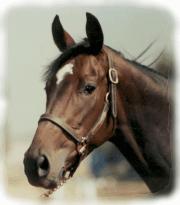A Horse, of Course with Don Blazer |
If you enjoy learning about horses, then you'll love our online courses. Each month you'll find a new column on our web site. We hope you'll enjoy it, and maybe e-mail us with questions or suggestions for other columns. A Horse, Of Course is a monthly column syndicated by Success Is Easy. If you like the column, call your local newspaper, or local horse publication and ask them to subscribe by contacting Success Is Easy. |
Rippling Muscles Don Blazer copyright©2011 When you’re young, you think muscles are for flexing. You like to show them off. When you get a little older, as I have, you know muscles take on a new function, that of harboring aches and pains. Actually the muscles of all animals have the specific purpose of producing motion, and for horses that includes running, jumping, bucking and kicking. Colts love to get out and exercise their muscles by zipping around the pasture, rearing, dodging and nipping at their mothers, then dashing off to join in more foal-time games. Of course, all this dashing about is nature’s way of building strong muscles. Muscles account for nearly 50 per cent of the total weight of a horse. The horse’s muscle system is directed by nerve stimulation and has the ability to contract and change shape. There are three types of muscles. Voluntary muscles: most often attached to the bony lever areas of the skeleton; they create movement by direct command from the horse’s brain. Involuntary muscles work without conscious direction from brain. Involuntary muscles include those which digest food, contract the pupils of the eye or function in breathing. Thirdly, there is the cardiac, or heart muscle which is in a class by itself even though it is an “involuntary” muscle. A horse is said to have “great heart” when he is a champion at any performance event. And it is true that champion horses actually have larger hearts than average horses. Most voluntary muscles are in sets of two and act in opposition to one another. One muscle may be contracting or flexing while the other’s effort is employed in straightening or holding. Voluntary muscles, even with good conditioning, can only work for short periods of time before becoming fatigued and in need of rest. A horse will drop his head and neck as the first sign that muscle fatigue has started. It is not long after that the entire system needs a rest. If rest isn’t given, some muscle damage is inevitable. Involuntary muscles can work for hours without showing fatigue. The heart gains its required rest during the split-second interval between beats. With horses, the muscle systems most subject to injury are the tendons and ligaments of the legs. Tendons are long narrow extensions of bulky muscle. Tendons take the action of bulky muscle across joints and in changes of direction. Ligaments are inelastic, and primarily serve the function of holding joints in place. Ligaments around the fetlock joint, for example, allow the joint to have direction flexion, but prevent lateral or sideways movement. Tendons and ligaments are often stretched, strained or torn from the bone when the horse is overworked or tired, or when twisted in an unnatural movement. Short heavy muscle denotes quickness and power and is known as “fast twitch” muscle. It is great for short bursts of speed, but it burns a lot of oxygen and produces high amounts of waste; so it is only useful for brief periods. Longer, thin muscle, called “slow twitch” muscle, is much better for endurance, but doesn’t produce quick power. A good combination of both types of muscle produces a well-balanced, versatile athletic horse. There are no secrets to building and caring for the muscles of a horse. Planned stresses (a training program) and good nutrition build the needed muscle for the desired performance. And remember, horses stay fit naturally and don’t need as much work as humans. After the planned stresses, adequate rest and a good rub down help muscles feel good and regain health. Working your horse in a designed training program is similar to sending your horse to a body building gym. My horse can’t hold a barbell, so I just let her carry a dumbbell. |
